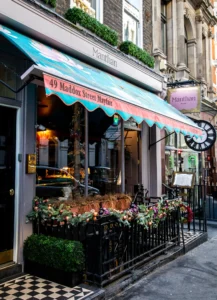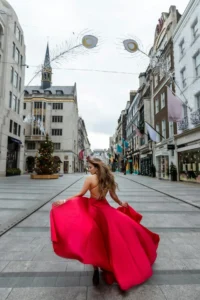Mayfair Historical Walk: Stories Etched into Its Streets
Mayfair, one of London’s most elegant districts, offers a rich Mayfair historical walk through cobbled streets and storied buildings. Though now synonymous with luxury, fashion, and fine dining, Mayfair was once a humble open field. Its transformation over centuries has left behind many clues – especially in the names of streets, the façades of historic buildings, and the echoes of past residents. Let’s take a walk through Mayfair and uncover the tales etched into its timeless charm.
The Origins of Mayfair: From Market Grounds to Aristocratic Address
 Mayfair owes its name to the “May Fair”, a raucous annual event held during the late 1600s. Originally based in Haymarket, the fair moved to the area that became known as Shepherd Market. Though the fair ended in the 18th century, the name “Mayfair” endured and soon began to define an increasingly refined quarter of the city.
Mayfair owes its name to the “May Fair”, a raucous annual event held during the late 1600s. Originally based in Haymarket, the fair moved to the area that became known as Shepherd Market. Though the fair ended in the 18th century, the name “Mayfair” endured and soon began to define an increasingly refined quarter of the city.
Once the fair moved, aristocrats started to build homes here. Wealthy families such as the Grosvenors and Berkeleys laid down roots, and their names still linger today in many of Mayfair’s streets and landmarks.
Street Names That Whisper Stories: Mayfair Historical Walk
Grosvenor Square
Perhaps Mayfair’s most famous square, Grosvenor Square gets its name from Sir Richard Grosvenor, whose family developed much of the area. The square was designed in the 1720s and has housed ambassadors, military leaders, and influential figures throughout history. During World War II, it became the base for General Eisenhower, the Supreme Commander of the Allied Forces.
Berkeley Street and Berkeley Square
These streets are named after the Berkeley family, who once owned a grand estate in the area. Berkeley Square, designed in the 18th century, is known for its plane trees – among the oldest in central London. Legend says the square is haunted, and its eerie stories only add to its mystique.
Curzon Street
Named after the Curzon family, long-time aristocrats with strong political ties, this street once boasted the homes of notable British figures. In fact, George Curzon served as Viceroy of India and left a mark on British history.
Notable Residents and Their Legacy
Florence Nightingale
The founder of modern nursing, Florence Nightingale, lived in South Street, Mayfair. Her presence here reminds us of Mayfair’s ties to national history. Despite the area’s luxury, Nightingale’s story brings a sense of duty, care, and public service to its past.
Winston Churchill
Churchill lived in various locations throughout London, but one of his most notable early residences was on Mount Street in Mayfair. He lived there during his younger days, when he was still shaping his political career. Today, a blue plaque honours his stay in the area.
Handel and Hendrix in London
In an unlikely twist of fate, two music legends – centuries apart – lived side by side. Composer George Frideric Handel lived at 25 Brook Street during the 1700s, while guitar legend Jimi Hendrix lived at number 23 in the 1960s. Today, their homes are preserved as a combined museum celebrating music’s enduring power across time.
Architectural Echoes of the Past: Mayfair Historical Walk
The Royal Arcade
 This Victorian shopping arcade, dating back to 1879, links Old Bond Street with Albemarle Street. With its arched glass ceilings and marbled elegance, the Royal Arcade continues to echo the refined shopping traditions of Mayfair’s past.
This Victorian shopping arcade, dating back to 1879, links Old Bond Street with Albemarle Street. With its arched glass ceilings and marbled elegance, the Royal Arcade continues to echo the refined shopping traditions of Mayfair’s past.
Claridge’s Hotel
Built in the early 1800s, Claridge’s became a favourite for royalty and the elite. During World War II, it even served as a makeshift sovereign ground for the exiled Yugoslav royal family. They declared Suite 212 to be Yugoslav territory so that a royal heir could be born on home soil.
Burlington Arcade
This elegant shopping arcade was built in 1819 by Lord George Cavendish, supposedly to stop litter from being thrown into his garden. Today, it remains a symbol of Mayfair’s unique blend of style and tradition. The uniformed beadles who guard it still enforce rules like “no whistling.”
A Living History at Every Corner: Mayfair Historical Walk
Walking through Mayfair is like flipping through the pages of a living history book. Each turn offers a name, a face, or a façade that connects the past with the present. The district has preserved its essence while embracing modernity. Luxury boutiques and Michelin-starred restaurants now share walls with Grade I listed buildings and Georgian terraces.
From the noble Grosvenors to revolutionaries like Hendrix, Mayfair has played host to a wide range of characters – each adding depth to its identity.
Conclusion: Let the Streets Speak
Mayfair’s charm lies not only in its beauty but also in its stories. It is more than a postcode – it is a memory of fairs, wars, art, and progress. Whether you’re strolling through its serene squares, admiring the grandeur of old homes, or shopping in historic arcades, remember: these streets have something to say.
So next time you’re in Mayfair, look up at the plaques, read the street signs, and let its rich past guide your steps. You may find that the most stylish district in London is also its most storied.